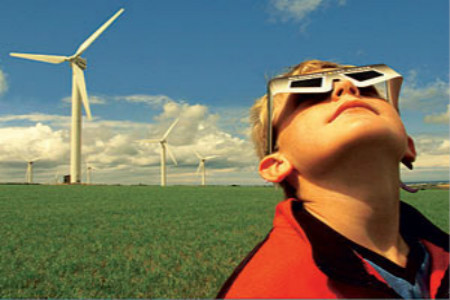The plan will require two transformations, one micro and one macro. The first is an unruly, subsidy-fed explosion of wind, solar and biomass power, a “strange mixture of idealism and greed,” as one energy boss calls it. The second is the effort to pull this into a system providing reliable and affordable electricity. Protagonists of the micro version see themselves as democratising economic and political power. The renewable-energy law entitles anybody who puts in a solar panel or a windmill to sell surplus power to the grid, receiving a generous “feed-in tariff” guaranteed over 20 years. This gives renewable electricity priority over conventional power. Not surprisingly, renewables grew ten times faster than the OECD average from 1990 to 2010 and now account for 20% of electricity output (see chart). The government’s target is 35% by 2020. Germany gets more electricity from renewable sources than any other big country.
能源轉(zhuǎn)型計(jì)劃將需要從微觀和宏觀兩個(gè)層面進(jìn)行轉(zhuǎn)化。第一個(gè)是依靠政府的補(bǔ)貼,大力開發(fā)風(fēng)能、太陽能以及生物能源,某能源老總稱之為一個(gè)“理想主義和貪婪主義奇怪的混雜物”。第二個(gè)指為把開發(fā)出的能源轉(zhuǎn)入一個(gè)能夠提供可靠且可負(fù)擔(dān)的電流體制所做的努力。微觀版的支持者視自己為民主化經(jīng)濟(jì)和政治力量。每位通過太陽能板或風(fēng)車向電網(wǎng)出售剩余電力的公民,都可憑借《可再生能源法》賦予的權(quán)利,在未來20多年內(nèi)享受“上網(wǎng)電價(jià)補(bǔ)貼政策”。這使人們在可再生能源與傳統(tǒng)能源二者中,優(yōu)先考慮前者。1990年至2000年間,德國的可再生能源增幅比世界經(jīng)合組織(OECD)的平均值快十倍自然也不足為奇,如今可再生能源占德國發(fā)電量的20%。德國政府的目標(biāo)是,在2020年將該比率擴(kuò)大至35%。德國利用可再生能源產(chǎn)電量為所有大型國家之首。

The return on capital can top 20% a year in the best spots. But do not confuse harvesters of sun and wind with electricity plutocrats. “One important goal is to break the monopoly” of the four big power companies that dominate the market, says Hermann Albers, president of the Federal Wind Energy Association. Municipal utility companies plan to boost their share of electricity production from a tenth to at least a fifth by 2020. More than 100 municipalities want to be “100% renewable”.
最佳地點(diǎn)的年資本回報(bào)率最多為20%。可您甭想用電力財(cái)閥們來唬弄太陽能和風(fēng)能的收獲者們。聯(lián)邦風(fēng)能協(xié)會(huì)會(huì)長Hermann Albers說,“重要目標(biāo)之一是打破四大電力公司主導(dǎo)市場的壟斷”。市政公用事業(yè)公司計(jì)劃在2020年前,將自己在電力生產(chǎn)中占得比率從10%,至少提高至20%。逾100個(gè)直轄市希望實(shí)現(xiàn)“100%利用可再生能源”。
The number of “energy co-operatives” has risen sixfold since 2007, to 586 last year. Solar parks have migrated from farms and family houses to apartment blocks. “Roof exchanges” match owners with investors. Niebull allows only wind farms in which residents can buy stakes, lest landowners become local fat cats and others rebel against the project. In 2010 over 50% of renewable-energy capacity was in the hands of individuals or farmers, according to trend:research, a consultancy. The big four had just 6.5%.
去年 “能源合作項(xiàng)目”數(shù)目為586個(gè),是2007年的六倍。太陽能電場也從田間地頭、獨(dú)立住宅遷到了公寓大樓。電場主通過“屋頂交換”項(xiàng)目找到匹配的投資者。尼必爾市僅容許風(fēng)力農(nóng)場居民購買股份,以免地主搖身變成地方“肥貓”,使其他人反對該項(xiàng)目。據(jù)資訊公司trend-research稱,2010年可再生能源產(chǎn)能的一半以上都落入個(gè)體或農(nóng)民手中。四大電力公司僅占6.5%。
This is perking up sleepy regions. Farmers are likelier to remain on the land. Services, from consultants who guide investors through the subsidy jungle to specialist windmill repairmen, have taken root in towns. The taxes paid by Niebull’s wind park are one of the town’s main sources of revenue; in smaller settlements they may be almost the only local source.
這也使那些尚未采取行動(dòng)的地區(qū)開始躍躍欲試。農(nóng)民們更愿意留在農(nóng)村。各項(xiàng)服務(wù)已在城鎮(zhèn)扎根:從在堆積如山的補(bǔ)助里為投資者引路的顧問,到專業(yè)風(fēng)車維修工。尼必爾風(fēng)力電廠納的稅費(fèi)成了城市主要稅收之一,而在一些小地方,風(fēng)場也許幾乎是地方稅收的唯一來源。
The micro-level works almost too well. Schleswig-Holstein plans to generate three times as much renewable energy as it consumes and to export the surplus south and west. Southern states are keen to produce their own renewable power, too. Bavaria talks of self-sufficiency. The states’ windpower targets add up to double the federal government’s goal of 36 gigawatts by 2020.
微觀層面的似乎運(yùn)作的太一帆風(fēng)順了。席勒斯威格-霍爾斯坦計(jì)劃生產(chǎn)的可再生能源是原來需求量的三倍,并計(jì)劃將剩余電量出口至德國南部、西部的城市。南方各州也熱切期望能自己生產(chǎn)可再生電力。巴伐利亞州提出要自給自足。截至2020年,各州的風(fēng)能目標(biāo)合計(jì)為聯(lián)邦政府36千瓦兆目標(biāo)的兩倍。
Solar power, which consumes half the total subsidy but provides just a fifth of renewable electricity, is racing ahead of target. The Energiewende raises costs, unsettles supply and provokes resistance at grass-roots level. The system coped with the first influx of renewable energy, says Rainer Baake, who heads a lobby group called Agora Energiewende. But the next 20% will require a transformation.
太陽能的發(fā)展超出目標(biāo), 它只耗費(fèi)總補(bǔ)助額的二分之一,卻提供了可再生電力的五分之一。能源轉(zhuǎn)型抬高了成本,攪亂了供給,還激起草根階層的反抗情緒。游說組織“能源轉(zhuǎn)型集會(huì)”的領(lǐng)導(dǎo)人Rainer Baake說,現(xiàn)有體制應(yīng)對了首批可再生能源的涌入,然而接下來的20%就需要轉(zhuǎn)變。
One fight is over who will pay. The most energy-intensive consumers are shielded from the feed-in tariff, leaving ordinary folk, including pensioners and the unemployed, to foot the bill. The nuclear shutdown pushed up industry’s electricity bills relative to its competitors, argues Annette Loske of VIK, which represents big consumers. The political assault on their exemption undermines the confidence they need to invest. An even bigger worry is supply interruptions, which can disrupt factories even if they last for fractions of a second. VIK says they have risen 30% in the past three years. The odds of outright power cuts have jumped.
第一階段的戰(zhàn)役已結(jié)束,誰來為之埋單?能源消耗量最大的用戶受上網(wǎng)電價(jià)的保護(hù),留下平民百姓,領(lǐng)養(yǎng)老金的老人已經(jīng)失業(yè)人員負(fù)擔(dān)費(fèi)用。來自大客戶代理商VIK的Annette Loske辯解道,與競爭對手相比,核電站的關(guān)閉抬高了工業(yè)的電費(fèi)。大客戶本需要樹立信心,而針對大客戶免稅的政治攻擊卻漸漸削弱了這份信心。斷電則是另一份更大的煩惱,供電哪怕只中斷幾分之一秒都會(huì)擾亂工廠作業(yè)。VIK稱,在過去三年里斷電頻率已上升至30%。突然停電的幾率猛增。 翻譯:王葭葦












